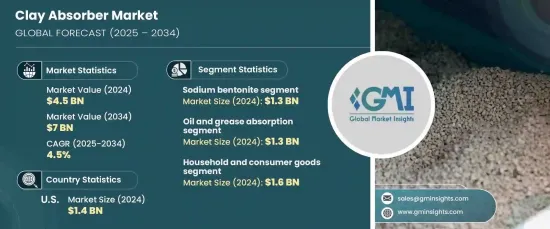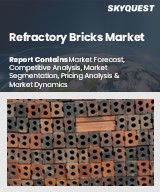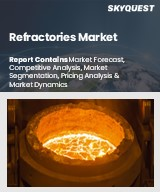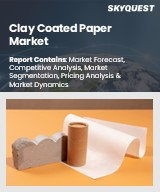
|
시장보고서
상품코드
1664851
점토 흡수제 시장 기회, 성장 촉진요인, 산업 동향 분석, 예측(2025-2034년)Clay Absorber Market Opportunity, Growth Drivers, Industry Trend Analysis, and Forecast 2025 - 2034 |
||||||
세계의 점토 흡수제 시장은 2024년 45억 달러의 평가액에 달하며, 2025-2034년에 4.5%의 CAGR로 견고하게 성장할 것으로 예측됩니다. 이러한 성장의 원동력은 환경 지속가능성에 대한 관심 증가, 산업 안전 규제 강화, 다양한 분야의 소비자(특히 애완동물 케어) 수요 증가에 기인합니다. 벤토나이트와 풀러즈어스로 만든 것을 포함한 점토 흡수제는 생분해성과 환경 안전성으로 인해 합성 흡수제를 대체할 수 있는 친환경적인 대안으로 각광받고 있습니다.

다양한 유형의 점토 흡수제 중 벤토나이트 나트륨은 시장 성장의 주요 기여자로 눈에 띄며 2024년에는 13억 달러로 평가될 것입니다. 이 분야는 2034년까지 연평균 복합 성장률(CAGR) 4.4%로 성장할 것으로 예상됩니다. 나트륨 벤토나이트는 우수한 팽창 능력으로 유명하며, 산업 환경의 유출 방지 및 반려동물 모래와 같이 빠른 흡수가 필요한 용도에서 높은 수요가 있습니다. 반면, 칼슘 벤토나이트는 팽창 능력은 낮지만 우수한 양이온 교환 특성으로 인해 시장의 다양한 용도에 적합합니다.
| 시장 범위 | |
|---|---|
| 시작연도 | 2024년 |
| 예측연도 | 2025-2034년 |
| 시작 금액 | 45억 달러 |
| 예상 금액 | 70억 달러 |
| CAGR | 4.5% |
애완동물 케어에서 중요한 역할을 하는 것 외에도 점토 흡수제는 2024년 13억 달러로 평가되었으며, 오일 및 지방 흡수 용도에서 사용이 증가하고 있습니다. 이 분야는 2025-2034년 연평균 복합 성장률(CAGR) 4.6%로 성장할 것으로 예상됩니다. 점토 흡수제는 제조 및 자동차 산업과 같이 유출유 관리 및 세척이 안전 표준을 유지하고 환경 준수를 보장하는 데 필수적인 산업에서 필수적입니다. 또한 수처리 분야에서의 사용도 증가하고 있습니다. 이러한 흡수제는 오염 물질을 걸러내어 산업 및 지자체 시스템 모두에서 수질을 개선하는 데 도움이 되기 때문입니다. 또한 공기질을 개선하고 엄격한 배출 규제를 준수하려는 산업계의 노력으로 인해 공기 및 가스 여과에 대한 점토 흡수제 수요가 증가하고 있습니다.
미국의 점토 흡수제 시장은 2024년 14억 달러로 평가되었고, 연평균 5.4%의 놀라운 성장을 보일 것으로 예상됩니다. 이러한 성장의 주요 요인은 산업 및 제조 부문 전반에 걸쳐 효과적인 유출 관리 솔루션에 대한 수요가 증가하고 있기 때문입니다. 환경 규제와 안전 기준은 기업이 보다 효율적인 흡수제를 채택하도록 유도하고 있으므로 미국 시장은 지속적인 성장세를 보일 것으로 예상됩니다. 친환경 기술이 발전하고 산업 수요가 지속적으로 증가함에 따라 점토 흡수제 시장은 지속적으로 확대될 것으로 예상됩니다.
목차
제1장 조사 방법과 조사 범위
- 시장 범위와 정의
- 기본 추정과 계산
- 예측 계산
- 데이터 소스
- 1차
- 2차
- 유료 정보원
- 공적 정보원
제2장 개요
제3장 업계 인사이트
- 업계 에코시스템 분석
- 밸류체인에 영향을 미치는 요인
- 이익률 분석
- 변혁
- 향후 전망
- 제조업체
- 유통업체
- 공급업체 상황
- 이익률 분석
- 주요 뉴스와 구상
- 규제 상황
- 영향요인
- 성장 촉진요인
- 친환경 제품에 대한 수요 증가
- 애완동물 케어 산업의 성장
- 엄격한 산업 안전 규제
- 업계의 잠재적 리스크·과제
- 원재료 가용성과 비용의 변동
- 신흥 시장에서의 낮은 인지도
- 성장 촉진요인
- 성장 가능성 분석
- Porter의 산업 분석
- PESTEL 분석
제4장 경쟁 구도
- 서론
- 기업 시장 점유율 분석
- 경쟁 포지셔닝 매트릭스
- 전략 전망 매트릭스
제5장 시장 추산·예측 : 제품 유형별, 2021-2034년
- 주요 동향
- 칼슘 벤토나이트
- 나트륨 벤토나이트
- Montmorillonite
- Attapulgite
- Fuller's earth
제6장 시장 추산·예측 : 용도별, 2021-2034년
- 주요 동향
- 유지 흡수
- 수처리
- 공기·가스 여과
- 애완동물 모래(Pet litter)
- 화학·산업용 유출 대책
- 농업
제7장 시장 추산·예측 : 최종 용도별, 2021-2034년
- 주요 동향
- 자동차
- 제조업·산업
- 가정용품·소비재
- 식품 및 음료
- 의약품·화장품
- 기타
제8장 시장 추산·예측 : 지역별, 2021-2034년
- 주요 동향
- 북미
- 미국
- 캐나다
- 유럽
- 영국
- 독일
- 프랑스
- 이탈리아
- 스페인
- 러시아
- 아시아태평양
- 중국
- 인도
- 일본
- 한국
- 호주
- 라틴아메리카
- 브라질
- 멕시코
- 중동 및 아프리카
- 남아프리카공화국
- 사우디아라비아
- 아랍에미리트
제9장 기업 개요
- Astrra Chemicals
- Bentonite Performance Minerals
- Clariant
- Cms Industries
- Ep Minerals
- Imerys
- Lonestar Bentonite
- Manek Active Clay
- Neelkanth Chemical Industries
- Swell Well Minechem
The Global Clay Absorber Market reached a valuation of USD 4.5 billion in 2024 and is projected to grow at a robust CAGR of 4.5% from 2025 to 2034. This growth is being fueled by the rising focus on environmental sustainability, increasingly stringent industrial safety regulations, and a growing demand from consumers across various sectors, particularly in pet care. Clay absorbers, including those made from bentonite and fuller's earth, are becoming favored eco-friendly alternatives to synthetic absorbents due to their biodegradable and environmentally safe properties.

Among the various types of clay absorbers, sodium bentonite stands out as a key contributor to market growth, valued at USD 1.3 billion in 2024. This segment is expected to grow at a CAGR of 4.4% through 2034. Known for its exceptional swelling capacity, sodium bentonite is in high demand for applications requiring rapid absorption, such as spill control in industrial environments and pet litter. On the other hand, calcium bentonite, while offering a lower swelling capacity, is valued for its superior cation exchange properties, making it highly suitable for a wide range of applications in the market.
| Market Scope | |
|---|---|
| Start Year | 2024 |
| Forecast Year | 2025-2034 |
| Start Value | $4.5 Billion |
| Forecast Value | $7 Billion |
| CAGR | 4.5% |
In addition to its pivotal role in pet care, clay absorbers are seeing increasing use in oil and grease absorption applications, which was valued at USD 1.3 billion in 2024. This segment is projected to grow at a CAGR of 4.6% from 2025 to 2034. Clay absorbers are indispensable in industries like manufacturing and automotive, where managing and cleaning spills are critical for maintaining safety standards and ensuring environmental compliance. Their use in water treatment is also gaining momentum, as these absorbers help filter contaminants and enhance water quality in both industrial and municipal systems. Furthermore, the demand for clay absorbers in air and gas filtration is on the rise, driven by industries seeking to improve air quality and comply with stringent emission regulations.
The U.S. clay absorber market, valued at USD 1.4 billion in 2024, is expected to grow at an impressive CAGR of 5.4%. This growth is primarily attributed to the increasing need for effective spill management solutions across industrial and manufacturing sectors. With environmental regulations and safety standards pushing businesses to adopt more efficient absorbent materials, the U.S. market is poised for continued growth. As eco-friendly technologies advance and industrial demand continues to rise, the clay absorber market is expected to experience sustained expansion in the years ahead.
Table of Contents
Chapter 1 Methodology & Scope
- 1.1 Market scope & definitions
- 1.2 Base estimates & calculations
- 1.3 Forecast calculations
- 1.4 Data sources
- 1.4.1 Primary
- 1.4.2 Secondary
- 1.4.2.1 Paid sources
- 1.4.2.2 Public sources
Chapter 2 Executive Summary
- 2.1 Industry synopsis, 2021-2034
Chapter 3 Industry Insights
- 3.1 Industry ecosystem analysis
- 3.1.1 Factor affecting the value chain
- 3.1.2 Profit margin analysis
- 3.1.3 Disruptions
- 3.1.4 Future outlook
- 3.1.5 Manufacturers
- 3.1.6 Distributors
- 3.2 Supplier landscape
- 3.3 Profit margin analysis
- 3.4 Key news & initiatives
- 3.5 Regulatory landscape
- 3.6 Impact forces
- 3.6.1 Growth drivers
- 3.6.1.1 Rising demand for eco-friendly products
- 3.6.1.2 Growth in the pet care industry
- 3.6.1.3 Stringent industrial safety regulations
- 3.6.2 Industry pitfalls & challenges
- 3.6.2.1 Fluctuating raw material availability and costs
- 3.6.2.2 Limited awareness in emerging markets
- 3.6.1 Growth drivers
- 3.7 Growth potential analysis
- 3.8 Porter’s analysis
- 3.9 PESTEL analysis
Chapter 4 Competitive Landscape, 2023
- 4.1 Introduction
- 4.2 Company market share analysis
- 4.3 Competitive positioning matrix
- 4.4 Strategic outlook matrix
Chapter 5 Market Estimates & Forecast, By Product Type, 2021-2034 (USD Million) (Tons)
- 5.1 Key trends
- 5.2 Calcium bentonite
- 5.3 Sodium bentonite
- 5.4 Montmorillonite
- 5.5 Attapulgite
- 5.6 Fuller's earth
Chapter 6 Market Estimates & Forecast, By Application, 2021-2034 (USD Million) (Tons)
- 6.1 Key trends
- 6.2 Oil and grease absorption
- 6.3 Water treatment
- 6.4 Air and gas filtration
- 6.5 Pet litter
- 6.6 Chemical and industrial spill control
- 6.7 Agriculture
Chapter 7 Market Estimates & Forecast, By End Use, 2021-2034 (USD Million) (Tons)
- 7.1 Key trends
- 7.2 Automotive
- 7.3 Manufacturing and industrial
- 7.4 Household and consumer goods
- 7.5 Food and beverages
- 7.6 Pharmaceuticals and cosmetics
- 7.7 Others
Chapter 8 Market Estimates & Forecast, By Region, 2021-2034 (USD Million) (Tons)
- 8.1 Key trends
- 8.2 North America
- 8.2.1 U.S.
- 8.2.2 Canada
- 8.3 Europe
- 8.3.1 UK
- 8.3.2 Germany
- 8.3.3 France
- 8.3.4 Italy
- 8.3.5 Spain
- 8.3.6 Russia
- 8.4 Asia Pacific
- 8.4.1 China
- 8.4.2 India
- 8.4.3 Japan
- 8.4.4 South Korea
- 8.4.5 Australia
- 8.5 Latin America
- 8.5.1 Brazil
- 8.5.2 Mexico
- 8.6 MEA
- 8.6.1 South Africa
- 8.6.2 Saudi Arabia
- 8.6.3 UAE
Chapter 9 Company Profiles
- 9.1 Astrra Chemicals
- 9.2 Bentonite Performance Minerals
- 9.3 Clariant
- 9.4 Cms Industries
- 9.5 Ep Minerals
- 9.6 Imerys
- 9.7 Lonestar Bentonite
- 9.8 Manek Active Clay
- 9.9 Neelkanth Chemical Industries
- 9.10 Swell Well Minechem



















